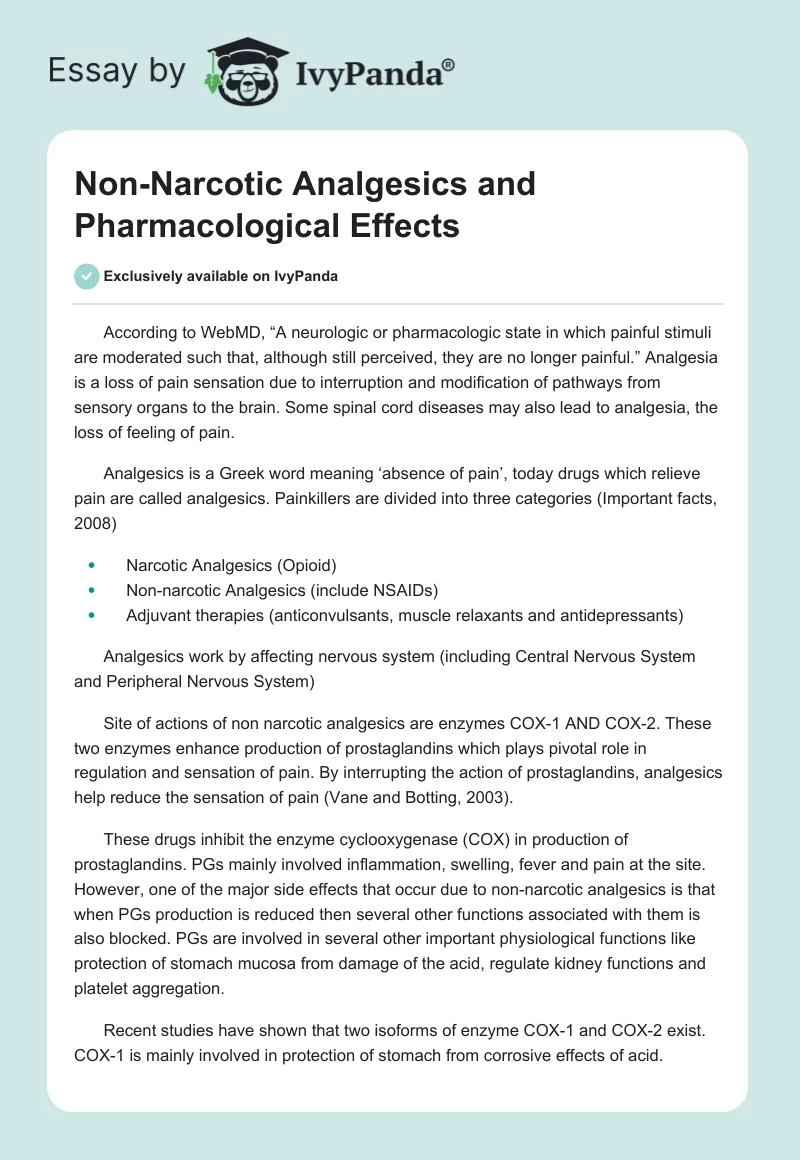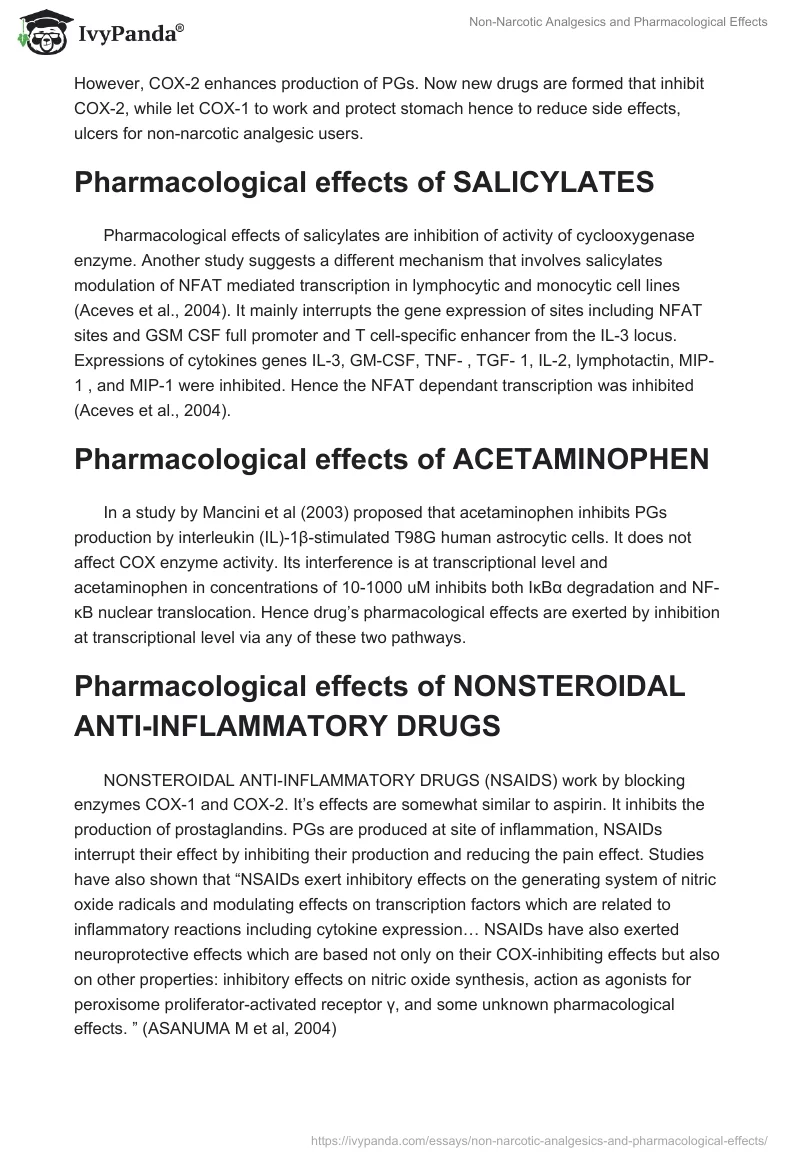According to WebMD, “A neurologic or pharmacologic state in which painful stimuli are moderated such that, although still perceived, they are no longer painful.” Analgesia is a loss of pain sensation due to interruption and modification of pathways from sensory organs to the brain. Some spinal cord diseases may also lead to analgesia, the loss of feeling of pain.
Analgesics is a Greek word meaning ‘absence of pain’, today drugs which relieve pain are called analgesics. Painkillers are divided into three categories (Important facts, 2008)
- Narcotic Analgesics (Opioid)
- Non-narcotic Analgesics (include NSAIDs)
- Adjuvant therapies (anticonvulsants, muscle relaxants and antidepressants)
Analgesics work by affecting nervous system (including Central Nervous System and Peripheral Nervous System)
Site of actions of non narcotic analgesics are enzymes COX-1 AND COX-2. These two enzymes enhance production of prostaglandins which plays pivotal role in regulation and sensation of pain. By interrupting the action of prostaglandins, analgesics help reduce the sensation of pain (Vane and Botting, 2003).
These drugs inhibit the enzyme cyclooxygenase (COX) in production of prostaglandins. PGs mainly involved inflammation, swelling, fever and pain at the site. However, one of the major side effects that occur due to non-narcotic analgesics is that when PGs production is reduced then several other functions associated with them is also blocked. PGs are involved in several other important physiological functions like protection of stomach mucosa from damage of the acid, regulate kidney functions and platelet aggregation.
Recent studies have shown that two isoforms of enzyme COX-1 and COX-2 exist. COX-1 is mainly involved in protection of stomach from corrosive effects of acid. However, COX-2 enhances production of PGs. Now new drugs are formed that inhibit COX-2, while let COX-1 to work and protect stomach hence to reduce side effects, ulcers for non-narcotic analgesic users.
Pharmacological effects of SALICYLATES
Pharmacological effects of salicylates are inhibition of activity of cyclooxygenase enzyme. Another study suggests a different mechanism that involves salicylates modulation of NFAT mediated transcription in lymphocytic and monocytic cell lines (Aceves et al., 2004). It mainly interrupts the gene expression of sites including NFAT sites and GSM CSF full promoter and T cell-specific enhancer from the IL-3 locus. Expressions of cytokines genes IL-3, GM-CSF, TNF- , TGF- 1, IL-2, lymphotactin, MIP-1 , and MIP-1 were inhibited. Hence the NFAT dependant transcription was inhibited (Aceves et al., 2004).
Pharmacological effects of ACETAMINOPHEN
In a study by Mancini et al (2003) proposed that acetaminophen inhibits PGs production by interleukin (IL)-1β-stimulated T98G human astrocytic cells. It does not affect COX enzyme activity. Its interference is at transcriptional level and acetaminophen in concentrations of 10-1000 uM inhibits both IκBα degradation and NF-κB nuclear translocation. Hence drug’s pharmacological effects are exerted by inhibition at transcriptional level via any of these two pathways.
Pharmacological effects of NONSTEROIDAL ANTI-INFLAMMATORY DRUGS
NONSTEROIDAL ANTI-INFLAMMATORY DRUGS (NSAIDS) work by blocking enzymes COX-1 and COX-2. It’s effects are somewhat similar to aspirin. It inhibits the production of prostaglandins. PGs are produced at site of inflammation, NSAIDs interrupt their effect by inhibiting their production and reducing the pain effect. Studies have also shown that “NSAIDs exert inhibitory effects on the generating system of nitric oxide radicals and modulating effects on transcription factors which are related to inflammatory reactions including cytokine expression… NSAIDs have also exerted neuroprotective effects which are based not only on their COX-inhibiting effects but also on other properties: inhibitory effects on nitric oxide synthesis, action as agonists for peroxisome proliferator-activated receptor γ, and some unknown pharmacological effects. ” (ASANUMA M et al, 2004)
References
- ASANUMA M. (1) ; MIYAZAKI I. (1) ; OGAWA N. (1) ; Neuroprotective effects of nonsteroidal anti-inflammatory drugs on neurodegenerative diseases : Potential therapeutic agents for Parkinson’s disease. Current pharmaceutical design ISSN 1381-6128. 2004, vol. 10, no6, pp. 695-700 [6 page(s) (article)] (88 ref.)
- Important Facts About Non-Narcotic Pain Drugs. Health Vital information with a human touch. Web.
- Mancinia, Carla Landolfia, Marta Muziob, Luciano Aquilinia, Lucia Soldoa, Isabella Colettaa, Angelo Guglielmottia, Alberto Mantovanib, Mario Pinzaa and Claudio Milanese. (2003) Acetaminophen down-regulates interleukin-1β-induced nuclear factor-κB nuclear translocation in a human astrocytic cell line. Copyright © 2003 Elsevier Ireland Ltd. All rights reserved.
- Mónica Aceves*, Ana Dueñas , Cristina Gómez*, Edurne San Vicente ,Mariano Sánchez Crespo* and Carmen García-Rodríguez2,* A New Pharmacological Effect of Salicylates: Inhibition of NFAT-Dependent Transcription. The Journal of Immunology, 2004, 173: 5721-5729. Copyright © 2004 by The American Association of Immunologists.
- Vane, J.R. and Botting, R.M. The Mechanism of Action of Aspirin. Copyright © 2003 Published by Elsevier Science Ireland Ltd. WebMD. Analgesia.
- Young-Jun Seoa, Min-Soo Kwona, Hee-Woo Choia, Seung-Min Choia, Joo-Sun Namb, Jin-Koo Leea, Jun-Sub Junga, Soo-Hyun Parka and Hong-Won Suha (2007) The differential effects of acetaminophen on lipopolysaccharide induced hyperalgesia in various mouse pain models. Copyright © 2008 Elsevier Inc. All rights reserved.


